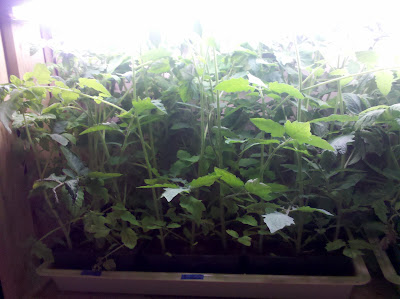All of the tomatoes made their way to the garden yesterday. I managed to fit 44 Rutgers determinate tomatoes and 17 Sungold tomatoes into the garden -- a few more than I thought I had room for.
The tomatoes had been looking a bit... crowded... in the house for over a week now, so my husband has been anxious to introduce them to the great outdoors. Unsurprisingly, he announced 'Let's plant out the tomatoes today!' yesterday early afternoon. After consulting the
average frost dates, and the 10-day forecast, I decided that it was safe to put them out. So much to his delight, I said 'Sure, let's plant out the tomatoes.'
 |
| The tomato jungle. |
So I brought out my two
jungles trays of tomatoes, and marched them over to the garden area. My husband wasn't far behind, so I started spouting out directions: 'This tray has only Rutgers tomatoes in it. This tray has both Rutgers and Sungolds, but they are labeled, so you just have to make sure you grab the right type...'
Husband: 'I'm not planting tomatoes.'
Me: 'What!?!?! But you suggested it!'
Husband: 'I suggested YOU plant out tomatoes. I'm going to do things that require more manpower.'
Me: *grumbles*
And that, ladies and gentlemen, is the story of how my husband tricked me into planting out 61 tomato plants by myself. And to be honest -- I am a bit sore from the planting out process, which I will finally get to:
The 2012 Tomato Planting Extravaganza:
Both types of tomatoes were planted with 24" spacing.
The Rutgers are a determinate type, which means they grow to a certain size and put on all their fruit. Luckily, this size is only 2-3 ft tall, so they do not need a trellis. They do, however, benefit from caging or staking of some sort. I chose to stake mine, for no other reason than the fact that I had bamboo laying around. I cut the bamboo stakes to a length of 4-5 feet.
Then I dug holes in my bed, drove the stakes in at least a foot, and planted a little Rutgers plant about 4-6" deep, next to the stake. I removed any lower branches that would have been buried.
 |
| Rutgers tomato, just after being transplanted. |
As the plant grows, I will tie it to the stake as necessary to support it.
The Sungolds were planted in an area with a preexisting trellis system, since they get tall and vine-y. My husband helped me tie cords to the top beam of the trellis supports that hang down to the tomatoes. After I planted them, I gently wrapped the cords around the stem of the tomato. As the plant grows, I'll continue to loop the cord around the main stem of the plant, which should aid in supporting it. Later in the season, I can also run cords horizontally if it looks like I'll need it.
 |
You can't see them in this picture, but there are Sungold
tomatoes along that white pipe. |
Both sets of tomatoes received a thick layer of pine straw to keep the soil moist, and to prevent weeds. And last, but not least, they got a watering system (PVC with holes in it), that can hook up to my rain barrels to make watering a breeze.
 |
| A view of all 44 Rutgers tomatoes with stakes! |
Oh, and in case you are wondering, my husband tilled some beds, and harvested a bunch of greens for processing. So he did his share of labor, too.















